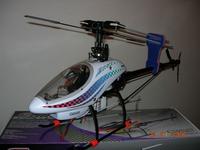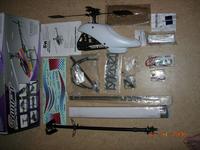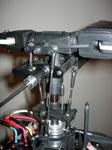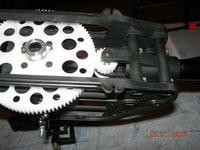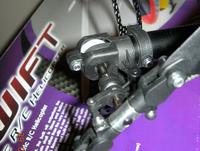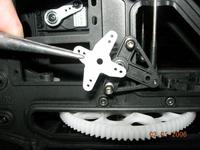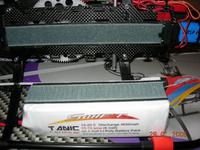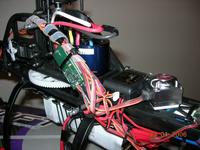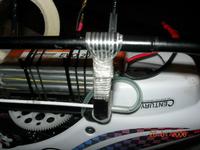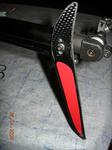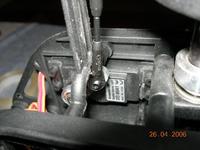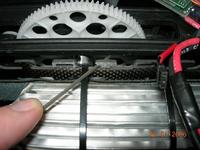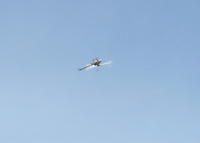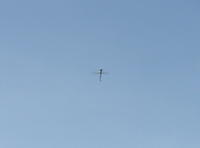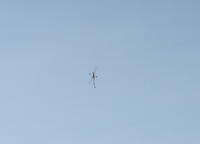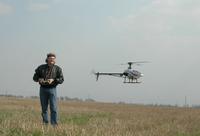
Electrohelicopter Century Swift
Very often it is necessary to hear erratic judgement of beginning helicopter pilots what easier at first to learn to fly by the small electrical helicopter, and grass-snake then to buy a severe large model. I repent, in due time (in a year 1998-99) and I so thought and tried to begin tutoring with kioshevskogo «Kontsept EP». The model has been staffed by 500th motor, 30 And the regulator, four mini servo, dorogushchim on those times a pezo-gyroscope and the most capacious on that time secondary generators - 1800 ma/H. As in an aftereffect it has appeared, the model not bad flies 3-4 minutes, then as much a time "is appealed for" on landing. «In an aftereffect» because as its training model to use it was not received. Easy, labile, to horror fragile, and for 5 minutes of tryings to take off and hang for a while you will learn to nothing.
Electric trains therefore has thrown, and has returned to them, as to an entertainment, about two years ago, having bought «Hummingbird». Very lovely helicopter, though "excitatory" and labile. Aloft wanton enough, and at emergencies rather proof to damages. The quite good toy for a dwelling unit, allows not to relax and tame in the evenings small stroptivtsa.
On a surge «Hummingbird’а» took to itself hardly bigger «Micro Star», has delivered on it (for the first time for itself) 3 phase engine, lithium-polymerous secondary generators and … has been literally dumbfounded! Such playfulness and dynamism simply did not expect and could not present at all. The model flies «as want» and «where want» not less than 10 minutes. At good machines and the gyro to "twist" all is possible practically. The trouble one – any breeze in the open air supplies pulp of problems, normally fly only indoors.
But electric trains have already interested seriously, and I began to search for full-scale models. It has appeared, that generators tender all of them more and more, and at very severe level (for example, Ion-X or LOGO 24). However, recently I became the adherent of models Century, therefore did not begin to hurry up and have fairly waited while on sale will occur for a long time promised «Swift 16».
The model complete equipment, assembly, nastrjka
Century tenders both the "bare" mechanics «Swift», and 7-9 complete equipments for all tastes: with a motor, the control unit, the secondary generator and a pinion. If you not the super-pro in electromodels to buy a complete set is more correct (after all corporation has spent half a year for trial more than 500 various power speed keys!) and is more low-cost. In my case it was «3А – Competition».
Well and it is terminating, it is not necessary to be greedy on on-board electronics. At me it:
- Numeral a servo (3 pieces) – Graupner DS 8041 on a swashplate and Graupner DS 8700G on a tailing;
- Gyro JR 490T
- PCM collector MC 19;
- On-board power supply (separately from the power!) - 4 pieces; GP 1500.
Do not forget about good charging for LiPo batteries, I use Graupner Ultramat 30 +.
Model assembly if there is an experience, does not compound problems. Operating instruction Century as it is customary, is builted by a principle «you and so all you know». A model construction very beautiful, qualitative, strong enough, with a lump of bearings. The head of the chief curl is patterned with checked Hawk and Predator.
The power take-off assembly on a tailing bears a strong resemblance to a construction of helicopters Mikado. It very simple and safe, but thus a tailing on an autorotation does not work. Was possiblly, there will be any tuning complete set later though structurally to make modifications very uneasy.
The assembly of a caudal curl is plain and trusty. Caudal traction bar is made of a rigid carboxylic tube. The tailing servo is established on pipeline clamps on a tail boom.
In a driving from a servo to a swashplate (Хели-3 a type, 120 hail.) it is used only two cradles (push-pool). The rear machine has one forward thrust directly to a plate. Such construction Century applies and on large Predator though there there is an additional tuning on three cradles a push-pool.
At assembly of hitches of drivings and cradles it is necessary to remember identity of the sizes of all thrusts, their parallelism and identity of adjusting angles. Geometry violations are fraught with "clumsy" controllability of model.
For safe fixing of the secondary generator to the lower carboxylic frame I have stuck down on a two-sided adhesive tape "stickseed" (clasp-burdock). Now was very friend to adjust affirmed centering, and there is no hazard of drift of the battery aloft. The elastic bands retaining the battery, regular. Afterwards they have appeared not so safe so now I use pipeline clamps.
Electronics on board is packed very simply.
Tuning of angles of the general step does not call any problems – all servo, cradles and thrusts are opened and easily accessible. Offensive there was a tuning of the control unit of motor Castle Creations «Phoenix 80». At first, it is necessary not to forget to turn out (under the operating instruction to chop a wire!) BEK – collector power supplies. Then in turn to set up 8 programs (in everyone from two to six adjustments) by means of the pen of gas of the sender. The program is made so, that at an error during tuning or at desire to change the program all tuned is zeroed and it is necessary to begin at first! Probably, Castle Creations thus boosts purchasing of interfaces for programming from the computer. Besides, it was not pleasant (and can, yet has not understood), the program of electronic simulation governor’а. It bolsters not enough high speed of the main curl, works is unpredictable and is not turned out from the sender. So while this tuning should be turned out.
Maiden flights
Certainly, in the winter normally to do some flying it was impossible. But as soon as the frost released (and on a frost, speak, LiPo secondary generators to work do not want) conducted trial for an athletic field in a yard. In the beginning has suffered with governor’ом (see above) but when has rearranged all on a customary condition (curves of gas programmed in the sender) all it was adjusted. The model flies easily and steadily, in a statics demonstrates dazzling stability. Thus instantaneously reacts to pens, behaves "priemisto" and it is dynamical.
Maintenance Century Swift
My Swift flew about two hours of a pure time. So it is possible to judge its letno-operational qualities really.
1. The chassis. Beautiful and easy "pinches" have appeared feeble and unadapted at all to rigid, and to "hardish" landings. Has slightly exceeded velocity at an autorotation or has landed model a little «on aircraft» - easy scrooping is distributed, and chassis foots break off endways at attachment of skis. Thus the helicopter does not jump aside ("does not bounce") from land, that is landing gears well, but only once damp.
Having broken two complete sets of foots, now in advance I reinforce their clad model adhesive tape, and gradually I think over a characteristic construction of legs from a carbon fiber-reinforced plastic.
2. An analogous problem with a beautiful and skeleton fin - a caudal bearing part. Has revamped itself from 2,0 mm of coal, and has now found on site Century strong (without pinholes) a tuning complete set.
3. The directing detail (link) of a swashplate has property to cling traction bar of a rear servo. It was necessary to notch.
As has rounded off sharp ridges on a carbon frame. These ridges very fast chafe regular elastic bands of attachment of secondary generators.
4. Has still found, that at a step-10 a hail. The swashplate densely rests against the upper clamper of a main shaft. Like not terrible, but, working on a roll and tangage in upside-down flight, has seen short-term falls of cycles and tailing yanks. It has appeared, that the plate at cants in the lower rule actually chocks a main shaft! Therefore has simply changed (has incremented by 3-4 cycles from factory advisories) length of thrusts of a skew, accordingly having moderated length of thrusts of a step and servolopatok.
5. Tuning of a controller of a motor without a cable as I wrote already, occupancy tiresome and offensive. Having received a cable, at once "has pumped out" from the Internet renewal of the program of my control unit Feniks-80 and has begun new tuning. From the computer it to do solid pleasure. But only if you know how to set up.
Not suspecting about any dirty tricks, I have established condition Auto LiPo (an autodetection lithium-polymerous of batteries) and condition Governor. Then has peeled arms and by means of a simple aircraft tachometre has begun measuring of cycles of the chief curl. Having ended, has built on a paper the relation schedule, and has spotted, that for obtaining on the chief curl of stable 1950 rpm (a condition of a statics of "norms") gas should be about 90 %. The gas curve (to be exact "shelf") in "norms" was received 0-90 %-90 %-90 %-90 %. Accordingly in "akro" for 2050 rpm it is a horizontal straight line on 95 %.
Has taken off – it was pleasant. Cycles stable easly, the helicopter is operated linearly and precisely. But this flying lasted 3-4 minutes, then on a flank at transferring to a subzero step cycles have spontaneously fallen, and motor power supply was turned out. The emergency autorotation – breaking of legs.
Second time has established manually a cutoff of power supply on 15 volt (the minimum - 2,5 In on one bank in, the battery), has turned out all overload protections. Effect - 5 mines of flying and switching-off on erect "candle". Again a minus of a foot of the chassis. In such spirit there were some more flyings while that the principle of tuning Governor’а at me irregular finally was not convinced!
Having considered and potereotezirovav, has come to such inference: calculation of admissible stable cycles for of the river should be guideed on all power line-up. Effect – such here the formula:
Cycles/on motor volt to increase by minimum operating voltage of 2,7 Volt/on a bank to increase by quantity of banks to increase by a reduction gearbox transmission ratio = the Peak stabilised cycles of the chief curl.
On my model it: 966 * 2,7 * 6 * 11/96 = 1793 rpm.
Certainly, now it is clear, that at 2000 rpm established by me at voltage drop of secondary generators (at category or large load) to = 2050 h 96/11/6/966 = 3,09 In governor any more in a state was to bolster cycles, i.e. actuated the peak gas, that even more as avalanche weighted-discharged batteries and called a self-acting cutoff of power supply!
Having established the stabilised 1700 rpm (72-73 % of gas), has departed without any problems, but any more so it is active as at 1950-2050 rpm. As has not pleased losses of flight time because of constant run-up of a curl (heightened power consumption) which one has compounded 2-3 minutes. For this parent, and because of the occurbed infraconscious mistrust to "clever" functions of the control unit, has returned to programmed curves of a step.
6. Model flyings call basically only pleasant emotions. The helicopter flies very stablly and steadily. Even the choppy wind of 5-7 m\s has not constructed notable problems. At modification of flying I generally have a feel of unreal ease, "imponderability" of model. I will a little feature simple figures:
- Pirouettes are executed very actively in plane without heels and huntings;
- Buttonholes can be done from "tumbling" in situ to the tall, extended figure;
- Flanks - the same from "tumble" to the long and smooth figure without appreciable falls;
- Upside-down flight while is received not absolutely well – the model starts to bank to the right, it is necessary to bolster constantly;
- At erect figures (zooms, candles) are feel, that model "podvisaet", instead of fails downwards as heavy-duty helicopters;
- The autorotation for me is very unusual without an operating tailing. To taxy out a roll (in an aircraft way) the altitude and peripheral speed is necessary. I can not brag yet, that is received easily and without problems.
7. And last. My complete equipment:
- Model: Century Swift-16.
- Diameter of the chief curl: 1210 mm.
- Diameter of a caudal curl: 210 mm.
- Length: 1020 mm.
- Weight: about 2550
- Flight time: 10 … 14 minutes, depending on a mode of flight.
- Motor: Neo 1907/1.5Y.
- The control unit: Castle Creations Phoenix-80.
- Secondary generators power: Tanic 6S1 LiPo, 3650мАч, 20C, 22,2 Century
- Secondary generators on-board: GP 4 NiMH 1500 mach.
- Servo of control of a swashplate: Graupner 8041.
- Control servo a caudal curl: Graupner 8700G.
- The gyro: JR 490T.
- The collector: Graupner MC-19.
- The sender: Graupner MX-22.
And tunings:
- The step curve "Normal" =-4, +3, +9. "Flight" =-6, +2, +10. «3D» =-10, 0, +10. "Autorotation" =-6, +4, +12 hail.
- The gas curve "Normal" = 0, +65, +90. "Flight" = +80, +75, +100. «3D» = +100, +85, +100 %.
- Double-face consumptions/exhibitors (nik/beater) "Normal" = double-face consumptions of 65 %, an exponent of 0 %. "Flight" = d.r. 75 %, an exponent of +24 %. «3D» and "Autorotation" = d.r. 85 %, an exponent of +24 %.
- Double-face consumptions of a caudal curl – 75 % on all conditions.
- Sensitivity giro on 35 % in conditions "normal" and "deduction".
Similar pages:
